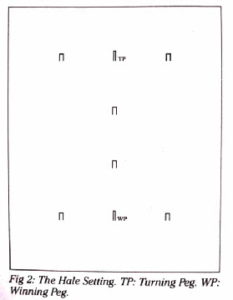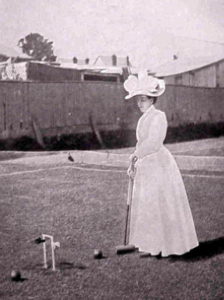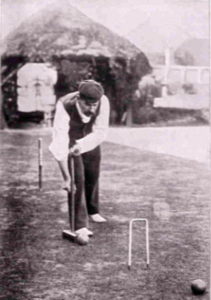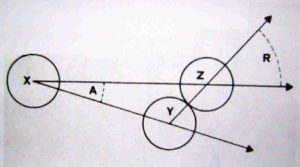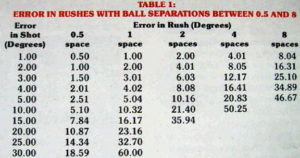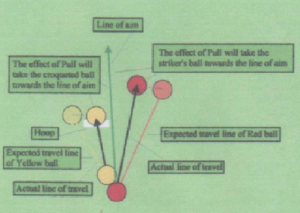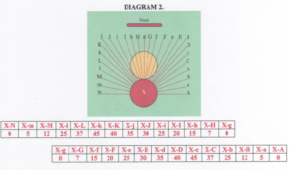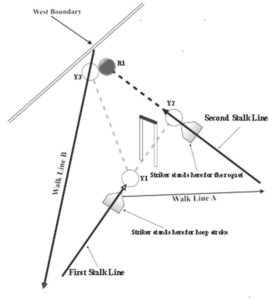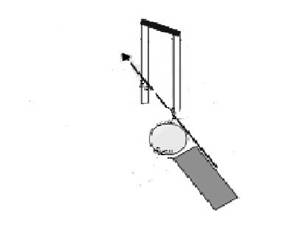Allen Parker - Issue 35 (2006)
(This article was published in the Croquet Gazette dated 27th. February, 1908. It seems that bad luck has always accompanied the losing player. Present day croquet players will no doubt sympathise with much else in this article. – Allen Parker)
The term ‘luck’, which is so often used to summarise the varying degrees of good and bad fortune incident in the game of croquet, is open to a large number of definitions, but in whatever sense it is used, we come ultimately to the bedrock idea of something wholly beyond human control and therefore super-human.
From this point it is a very short step to the idea of luck being the special attribute of an imaginary deity, and in so far as we are vastly more impressed by bad luck than the reverse, it is more usual to associate this despotic control with the personality of a devil than a benevolent deity. Hence such expressions as ‘the devils own luck’.
Some of the multitude of meanings of luck as applied to croquet may repay with interest a little reflection, and since good luck to one side is the reverse to the other, we may use the single word to express a double meaning without misunderstanding.
Even before the game commences luck obtrudes itself in the draw. One player has a succession of easy tasks while another runs up against formidable opponents in round after round. A’s path is a path of roses, B’s one of thorns, ere they meet in the final.
Luck may or may not be dependent on the play itself. It is luck pure and simple to make a roquet by glancing off a wire if such an eventuality did not enter the player’s mind beforehand, but it is luck of a different kind to bring off a long roquet at the most desirable moment, and again, it is a different kind of luck to find a strong opponent ‘off’ his game. The ‘luck of the toss’, of which we hear so much in cricket, hardly exists in croquet, thanks to the equal chances offered to both sides by the method of commencing the game.
Bad luck must be carefully distinguished from bad play. One may hear a twelve-bisquer exclaim his luck in getting wired from the ball he has taken off to, but this sort of luck rarely occurs to a good player who keeps in mind the possibility of little accidents of the kind, and avoids them by proper care. Or again, a thoughtless player, after running a hoop, roquets a ball beyond; he then finds that a hoop obstructs the course of one of the balls in taking croquet. This is not bad luck but lack of forethought.
Nowhere is the luck of the game more in evidence than in long shots. Time after time when we are down on our luck (we are generally playing badly, by the way, on these occasions) we miss by a hairbreadth, while our opponent seems to hit by the same margin. But the crowning point of all is that long shot when we are laid up to go out! How is it that our opponent always comes in on that particular shot? It is hard to escape the conclusion that the extra care and attention bestowed at these critical moments does materially help us to shoot straight.
Perhaps both sides have something to do with the result. May not our own anxiety lest he should hit act in some telepathic manner as a stimulus to the opponent? Certainly there are times when we feel ‘in our bones’ that the opponent is certain to hit, and he does; less commonly we leave a far from difficult shot with the utmost confidence in a miss, and we are justified by the result. Everyone must admit this subtle influence of one player on another, an influence we can realise without being able to explain.
A curious and interesting fact to be observed is the striking force with which we note our opponent’s good luck and our own bad luck, while we remain remarkably inobservant of the reverse conditions. It is to be observed that the explanation of the mystery is very simple, and may be summed up in the single word ‘selfishness’. It is so easy to persuade ourselves that our own good luck is the just reward of our play, or at least a trifle on account against the heavy debt of bad luck owing to us.
Luck, be it good or bad, is fairly consistent in two respects only. In the first place luck generally follows the winner. This does not mean that the winner succeeds because he has better luck, but rather expresses the rule that the worse you play the more bad luck you will be certain to get. In the second place luck, good or bad, will follow you consistently for a time. Luck comes in ‘runs’. One week you may successfully stake your chances time after time in a manner that violates some principle of tactics. You go a rocky ‘no-trumper’ and romp home. The very next week perhaps you break the same rule just once and pay the just penalty. When your luck is ‘in’, back it for all it is worth. There is a tide in the affairs of croquet players. When your luck is ‘out’ you will be wise to take a week off.
At present there is no such blind worship of the goddess of chance by croquet devotees as is often seen in some other games. At bridge (if we may credit ladies’ newspapers) many are the charms and sacrifices offered to invoke the smiles of the fickle goddess. The golfer playing at the top of his game one day has been known to take infinite pains to dress in a similar manner to the minutest detail on the next, lest the tiniest deviation in his attire should invoke the wrath of the malignant fate.
Can we imagine a lady croquet player a similar slave to base superstition? Even the belief that red and yellow will be luckier than blue and black is very rare in modern days, though perhaps some of us are inclined to be a trifle superstitious now and again in choosing the colours with which we have just been successful in the last game; but even in this case we like to adduce the more logical reason of a desire to avoid the possible confusion of a change in colours.
It has not yet been suggested that by turning the mallet round three times our luck will change in response. Our particular goddess of luck does not demand a worship of ritual, nor will she be coerced by curses, but rather should she be wooed as the handmaid of success.
MEDICUS
